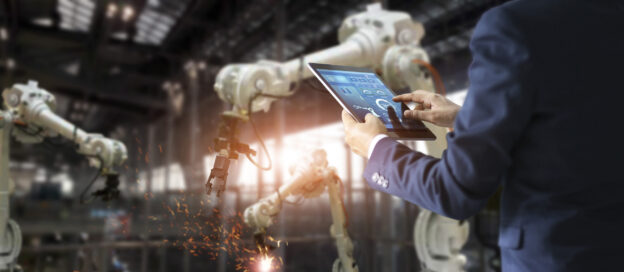- In a world of uncertainty, manufacturers face complex supply chain disruptions.
- These challenges present an opportunity to move towards more resilient autonomous supply chains.
- Here we outline how to achieve this business imperative and explain the societal benefits.
In today’s rapidly evolving global economy, manufacturers are grappling with increasingly complex challenges. From supply chain disruptions and shifting consumer expectations to environmental regulations and geopolitical uncertainties, the industry faces mounting pressures that demand resilience, agility and innovation.
Yet, within these challenges lies a transformative opportunity: the ability to harness artificial intelligence (AI) to build digital, adaptive and ultimately autonomous supply chains. Organizations that embark on this journey today will not only future-proof their supply chains, but also gain a competitive advantage in a world that prioritizes efficiency, sustainability and intelligent decision-making.
The roadmap from digital to autonomous
Supply chains are dynamic ecosystems that must continuously evolve to remain efficient and resilient. Achieving this transformation requires a three-stage approach, beginning with digitalization and progressing towards adaptability and autonomy.
Stage 1. Digital: laying the foundation
The first step in the journey is digital transformation, which replaces outdated, manual and paper-based processes with integrated, cloud-based systems. This stage focuses on data collection, visibility and connectivity, enabling organizations to gain real-time insights into their operations. Digitalization ensures greater control, transparency and efficiency, allowing businesses to make data-driven decisions and optimize workflows.
Example: A company migrating from a legacy warehouse management system to a cloud-based Enterprise Resource Planning (ERP) platform with integrated digital supply chain capabilities. This shift enables end-to-end visibility, enhances coordination and improves response times to market fluctuations.
Stage 2. Adaptive: integrating intelligence
Once digital foundation is in place, organizations can leverage AI technologies such as machine learning, predictive analytics and digital twins to build adaptive supply chains. These intelligent systems analyse vast datasets, forecast disruptions and optimize resource allocation, enabling businesses to proactively address challenges and capitalize on new opportunities.
Example: Generative AI is transforming product design and formulation. By analysing regulatory requirements, sustainability parameters and consumer preferences, AI can propose innovative product formulations that meet compliance standards while accelerating time-to-market.
Stage 3. Autonomous: the future of supply chains
The ultimate vision is a supply chain that operates autonomously with minimal human intervention. Autonomous systems leverage advanced AI technologies, including agentic AI capabilities, to predict, adapt and execute decisions in real time. These systems not only enhance operational efficiency, but also free up human expertise for strategic planning and innovation.
Example: AI-driven visual parts inspection in manufacturing is revolutionizing incoming quality control. High-resolution cameras analyse products in real-time, detecting defects such as scratches or misalignments and autonomously classifying items as “pass” or “fail.” This automated process reduces rework, minimizes recalls and ensures consistent product quality.
How is the World Economic Forum contributing to build resilient supply chains?
Addressing key challenges in AI integration
The vision of AI-powered supply chains presents a compelling future, but the journey towards this reality is fraught with challenges. Organizations must navigate a rapidly shifting technological landscape while ensuring that their digital infrastructure is equipped to handle the demands of AI-driven operations. From integrating disparate data sources to overcoming organizational resistance, the road to AI adoption requires careful planning and strategic investment. The following examples highlight some of the most commonly faced challenges that businesses must address to achieve a seamless and efficient AI-powered supply chain.
Data quality and accessibility
AI is only as powerful as the data it processes. Inconsistent, outdated, or incomplete data can compromise the effectiveness of AI models. Establishing robust data governance, ensuring real-time data access, and integrating structured and unstructured data sources are critical steps in overcoming this challenge.
Organizational readiness
Many businesses still rely on legacy on-premise systems that hinder AI scalability. Transitioning to cloud-based platforms and fostering a culture of digital literacy are essential for seamless AI adoption. Cross-functional collaboration within organizations and upskilling the employees are also vital to ensuring the successful deployment of AI-driven solutions.
Regulatory volatility
AI regulations are evolving rapidly. Frameworks such as the European Union AI Act are shaping the regulatory landscape, requiring organizations to proactively align with compliance standards. AI models must be reliable, responsible and explainable to meet ethical and legal requirements.
Cost and complexity
AI implementation requires significant investment in infrastructure, training, and talent acquisition. Organizations can mitigate these barriers by adopting scalable, cloud-based AI solutions that simplify deployment and reduce upfront costs.
Building resilient and autonomous supply chains
- Embrace a phased approach: Every organization’s AI journey is unique. A phased approach – starting with digital transformation, progressing to AI-driven adaptability and ultimately achieving autonomy – ensures a structured and manageable transition.
- Invest in talent and training: Building a workforce skilled in AI, data analytics and critical thinking is essential for AI success. Upskilling employees ensures they can effectively use AI tools while understanding their limitations and maximizing their potential.
- Prioritize responsible AI: Trust and transparency are crucial for AI adoption. Organizations must adhere to ethical guidelines, ensure AI system reliability, and align their AI initiatives with evolving regulatory standards.
- Foster collaboration: AI-driven supply chain transformation requires collaboration among technology providers, policymakers, and industry stakeholders. Initiatives such as the World Economic Forum’s Next Frontier of Operations facilitate knowledge sharing and best-practice adoption, accelerating AI-driven innovation.
Global implications
AI-driven supply chains are more than just a business imperative, they present a broader societal opportunity. By improving efficiency, reducing waste, and optimizing logistics, autonomous supply chains contribute to sustainability goals, minimizing environmental impact while enhancing economic resilience.
Through strategic partnerships, thought leadership and actionable AI initiatives, businesses can unlock the full potential of intelligent supply chains, creating systems that are agile, inclusive, autonomous and future-ready.
https://www.weforum.org/stories/2025/03/harnessing-ai-technology-to-build-autonomous-supply-chains/





